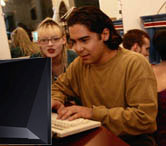
THURSDAY, Oct. 28 (HealthDay News) — A new study provides insight into the brain’s ability to detect and correct errors, such as typos, even when someone is working on “autopilot.”
Researchers had three groups of 24 skilled typists use a computer keyboard. Without the typists’ knowledge, the researchers either inserted typographical errors or removed them from the typed text on the screen.
They discovered that the typists’ brains realized they’d made typos even if the screen suggested otherwise and they didn’t consciously realize the errors weren’t theirs, even accepting responsibility for them.
“Your fingers notice that they make an error and they slow down, whether we corrected the error or not,” said study lead author Gordon D. Logan, a professor of psychology at Vanderbilt University in Nashville, Tenn.
The idea of the study is to understand how the brain and body interact with the environment and break down the process of automatic behavior. “If I want to pick up my coffee cup, I have a goal in mind that leads me to look at it, leads my arm to reach toward it and drink it,” he said. “This involves a kind of feedback loop. We want to look at more complex actions than that.”
In particular, Logan and colleagues wondered about complex things that we do on autopilot without much conscious thought. “If I decide I want to go to the mailroom, my feet carry me down the hall and up the steps. I don’t have to think very much about doing it. But if you look at what my feet are doing, they’re doing a complex series of actions every second,” Logan explained.
Enter the typists. “Think about what’s involved in typing: They use eight fingers and probably a thumb,” Logan said. “They’re going at this rate for protracted periods of time. It’s a complex act of coordination to carry out typing like this, but we do it without thinking about it.”
The researchers report their findings in the Oct. 29 issue of the journal Science.
The research suggests that “the motor system is taking care of the keystrokes, but it’s being driven by this higher-level system that thinks in terms of words and tells your hands which words to type,” Logan said.
Two autonomous feedback loops are involved in this error-detection and correction process, the researchers said.
What’s next? “By understanding how typists are so good at typing, it will help us train people in other kinds of skills, developing this autopilot controlled by a pilot [typist],” he said.
Gregory Hickok, director of the Center for Cognitive Neuroscience at the University of California at Irvine, said such research can indeed lead to advances.
Simply reaching for a cup is a fairly complicated process, said Hickok, who’s familiar with the study findings. “Despite all that is going on, our movements are usually effortless, rapid, and fluid even in the face of unexpected changes,” he said.
“If we can understand how humans can achieve this, we might be able to build robots to do all sorts of things, or develop new therapies or build prosthetic devices for people who have lost their motor abilities due to disease or injury,” he said.
More information:
The U.S. National Institute of Neurological Disorders and Stroke has more on the brain.

